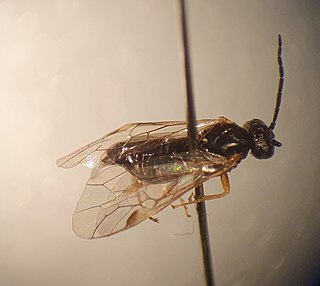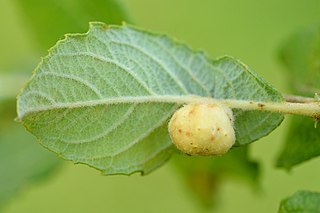Synanthedon flaviventris, the sallow clearwing, is a moth of the family Sesiidae. The larvae form pear-shaped galls on sallows.

Rabdophaga salicis is a gall midge which forms galls on sallows. It was first described by Franz von Paula Schrank in 1803.
Rabdophaga dubiosa is a gall midge which forms galls on the young shoots of willow.

Rabdophaga pierreana is a gall midge which forms galls on the young shoots of willow. It was first described by Jean-Jacques Kieffer in 1909.
Rabdophaga nielsenii is a gall midge. It was first described by Jean-Jacques Kieffer in 1906. The larvae tunnel in the shoots of bay willow and may cause the shoots to swell slightly.
Euura destricta is a species of sawfly belonging to the family Tenthredinidae. The larvae feed on the leaves of willow.

Rabdophaga nervorum is a gall midge which forms galls on the leaves of sallows. It is found in Europe and was first described by the French entomologist, Jean-Jacques Kieffer in 1895.

Iteomyia capreae is a gall midge which forms galls on willows. It was first described by Johannes Winnertz in 1853.

Aculus tetanothrix is a species of mite which causes galls on the leaves of willows. It was first described by Alfred Nalepa in 1889.

Aculus laevis is a species of mite which causes galls on the leaves of sallows. It was first described by Alfred Nalepa in 1892.
Euura dolichura is a species of sawfly belonging to the family Tenthredinidae. It was first described by Carl Gustaf Thomson in 1871. The larvae feed within galls on the leaves of willow. Some of the Euura species of sawfly are closely related and placed in groups of similar species. E. dolichura is a member of the Euura dolichura species group.
Euura nigricantis is a species of sawfly belonging to the family Tenthredinidae. The larvae feed within galls on the leaves of dark-leaved willow. It was described by Jens-Peter Kopelke in 1986.

Euura proxima is a species of sawfly belonging to the family Tenthredinidae. The larvae feed on the leaves of willows, creating galls and was described by Jean Guillaume Audinet-Serville in 1823.
Euura triandrae is a species of sawfly belonging to the family Tenthredinidae. The larvae feed on the leaves of almond willow and was first described in 1941.
Euura bridgmanii is a species of sawfly belonging to the family Tenthredinidae. The larvae feed on the leaves of sallows. It was first described by the entomologist Peter Cameron in 1883.
Euura pustulator is a species of sawfly belonging to the family Tenthredinidae. The larvae feed internally in a gall formed on the leaves of tea-leaved willow and diamondleaf willow.

Euura pedunculi is a species of sawfly belonging to the family Tenthredinidae. The larva feed within galls on the leaves of sallows. It was first described by Theodor Hartig in 1837.
Euura collactanea is a species of sawfly belonging to the family Tenthredinidae. The larva feed within galls on the leaves of willows. It was first described by Arnold Förster in 1854.
Massalongia rubra is a species of gall midge which forms galls in the leaves of birch. It was first described by the French naturalist and entomologist, Jean-Jacques Kieffer in 1890 and is found in Europe.









